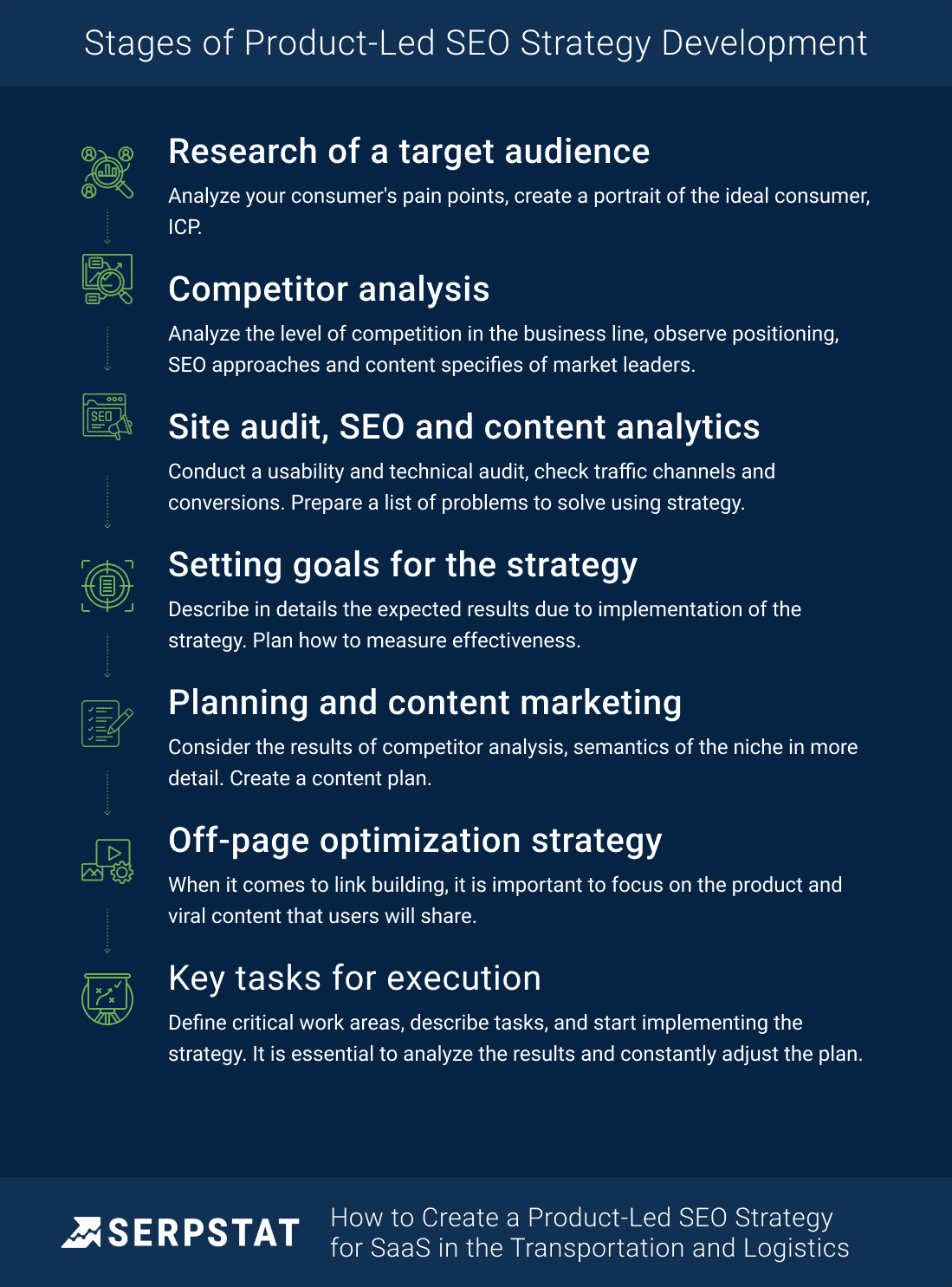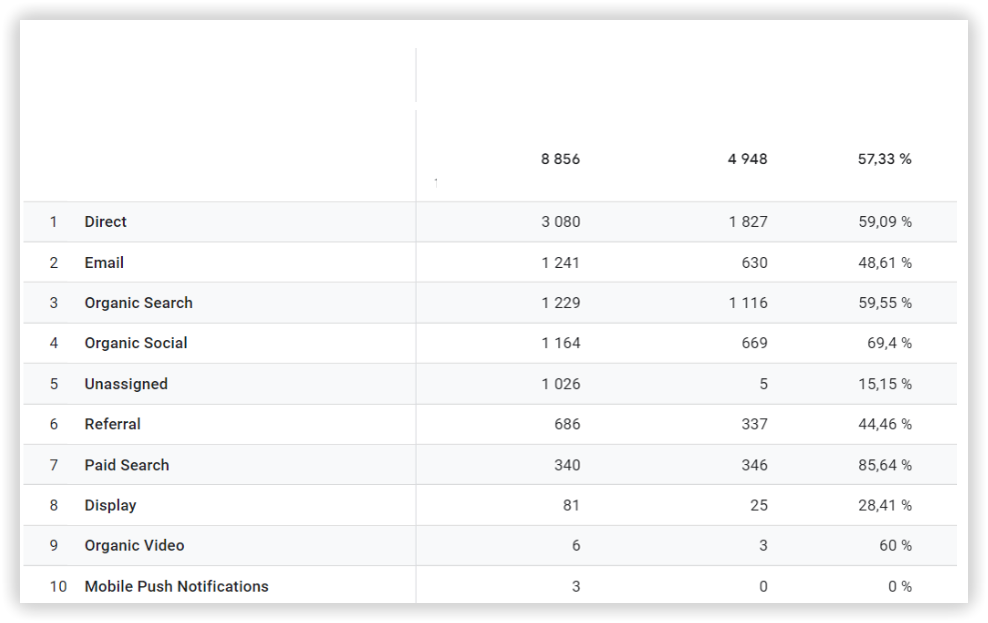Start Exploring Keyword Ideas
Use Serpstat to find the best keywords for your website
How to Create a Product-Led SEO Strategy for SaaS in the Transportation and Logistics

How to build a product-led strategy? Step-by-step guide
- Audience Research: creating an Ideal Customer Profile (ICP)
- Competitor analysis
- Website audit, analytics
- Goal-setting
- How to create content for your brand: content plan
- How to get backlinks: proven strategies
Why does a SaaS startup need an SEO strategy?
AutoBI focuses specifically on SEO to attract targeted users and reduce lead costs as an alternative to competitors' strategies. In addition, the company builds an approach based on the product-led principle, i.e., around the product and its customer benefits.
This approach attracts users and, at the same time, increases the chances of getting better positions (for example, through quality content that meets the user's needs).
How to build a product-led strategy? Step-by-step guide
- The SaaS model is different from traditional software. In such products, users pay for the service as a subscription so incorrect pricing can alienate potential customers.
- SEO's goal is not limited to improving the site's ranking in the SERP by keywords and getting traffic. High-quality content on the website, backlinks, and mentions of the service not only increase authority from the point of view of search engines but also increase brand loyalty, which contributes to an increase in the audience of active users
- In addition to SEO performance indicators, SaaS metrics such as MQL (marketing qualified lead), SQL (sales qualified lead), MRR (monthly recurring revenue), and ARPU (average revenue per user) are valuable to track.
- In our strategy, we leave room for experimentation and market trends since the product and market are constantly evolving. In order to accommodate product changes, the strategy must remain flexible.

1. Audience Research: Creating an Ideal Customer Profile (ICP)
For AutoBI, we formed the following portrait of an ideal client:
- A convenient and straightforward site structure is necessary to easily search for features, contacts, prices, and reviews. Our ICPs don't have much time, so the most relevant sections should be available right away.
- The site's content should answer questions related to the product in the client's language. We should use clear and concise formats and write the benefits of the service in terms of the pain points and challenges of our ICP.
- Key pages should contain elements that increase loyalty to the service (expert comments and reviews from real users, also in video format).
2. Competitor analysis
For example, let's check a keyword related to a product — "GPS monitoring systems" — and use it as a starting point for finding and analyzing competitors.

We recommend breaking down the competitor analysis into several areas:
- How to control fuel consumption?
- Is it possible to cheat, bypass, or disable the GPS tracker and GPS system?
- What are jammers and anti-jammers?
- Public transport tracking system: the features of urban logistics
- Truck route maps for Europe
- Truck fuel consumption
- Driver control: how to manage employees of a large organization

- Analysis Of Competitors' Websites: An Extensive Guide
- How to Conduct Competitor Analysis and What Approaches To Use At Each Step
- How To Carry Out A Quick Analysis Of Competitors' Contextual Advertising (PPC)
3. Website audit, analytics

Sometimes the search intent doesn't separate the tracking equipment from the system: GPS tracker + monitoring system = one request, but the search starts with the tracker.

4. Goal-setting
S (specific) — the specificity of the goal. The narrower a goal is, the clearer its steps will be.
M (measurable) — If no actual metrics indicates the strategy's success, then the goal is set incorrectly.
A (achievable) — This aspect of goal setting should neutralize the unrealistic expectations that often accompany SEO.
R (relevant) — The goal should be necessary for a particular direction and the company.
T (time-bound) — limited in time.
For example, reaching the top 3 in a month is an unattainable, immeasurable, irrelevant goal. It needs to be clarified what keywords we will get at the top and whether these queries will lead target users to the product.
ROMI (Return on Marketing Investment) indicator plays a significant role in AutoBI goal-setting). Since it was planned to reduce the cost of attracting new customers, marketing activities were carefully evaluated. We formed our goal: to make 100% ROMI in one year, and optimize paid traffic channels, Fb Target, and E-mail newsletters. In addition, it will shorten the transaction cycle.
5. How to create content for your brand: content plan
Delays in developing new pages, categories, and site sections can harm the business. The sooner you create resource pages, the better. Here are some reasons:
- you will have content to attract additional traffic;
- users will be able to share links, blog-posts, and other information;
- you can detect high-performing pages for further improvements;
- you can optimize internal linking;
- these pages accumulate the age of the URL.
For the target audience to find the platform in the search, it is more manageable to collect the system's main features and think over the associated topics and content formats. The content should sufficiently describe the product from the point of view of search engines and contain the semantics that customers use to find solutions.
- Catalog of machinery and equipment
- Interactive control panel
- Groups of machinery and equipment
- Automatic tracking of traffic fines
- Users and permissions Module
- Creation of the company structure
- Open API for integrations
- SaaS control panel
- Parts Inventory Management
- Telematics and monitoring module
- Notification module
- Identification by VIN and license plate number
- Connecting GPS trackers
- Insurance contracts
- Service requests for repairs




- AutoBI pricing
- Integrations with AutoBI
- Opinions about AutoBI
- AutoBI and/or FieldBI (competitor comparison).


6. How to get backlinks: proven strategies
An example of such a strategy is Glassdoor, which creates unique content related to a niche (research, ratings, and polls). Such studies are cited on external websites and receive links (Glassdoor has more than 15.1M external links).


For example, as a result of studying user feedback, you can find weaknesses in the product:
- Essential tools for the user need to be included.
- There needs to be more information about the product: instructions, use cases, and videos that the user needs.
- The design and interface of the service could be more convenient for use and quick navigation.
In addition, finding partners is essential to increase the number of external links. With the help of backlink analysis tools, we study the mentions of competitors and select high-quality resources for publishing guest articles on transport analytics.
Strategy implementation
We managed to identify the most relevant areas for our business and set tasks:
- Searching for and attracting additional investments for the development of the project.
- Expanding the functionality of the platform.
Related Use Cases
Discover More SEO Tools
Website Audit
Website SEO analysis – gain detailed insights into your website's technical health
Batch Analysis of Competitors' Domains
DA Domain Checker – get valuable information about the competitors' domains
AI Content Tools
AI Content Marketing Tools – simplify and optimize the content creation process
Local SEO Tool
Our local SEO platform – optimize your website for maximum impact
Recommended posts
Cases, life hacks, researches, and useful articles
Don’t you have time to follow the news? No worries! Our editor will choose articles that will definitely help you with your work. Join our cozy community :)
By clicking the button, you agree to our privacy policy.


